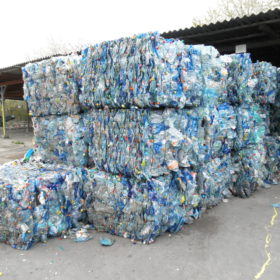
Scientists in the United States have used microwaves to convert ubiquitous plastic packaging material polyethylene terephthalate into a battery electrode component. The researchers say anodes based on the material could be suitable for both lithium-ion and sodium-ion devices.
Scientists at Purdue University in the U.S. state of Indiana have developed a process to convert waste plastic into battery components.
Polyethylene terephthalate (PET) is one of the most heavily used materials in the world and is found in food and drinks packaging, polyester clothing and a huge range of other consumer and industrial materials. Though widely recycled, the mountains of PET in circulation make it a significant contributor to plastic pollution – North American plastics industry association PETRA estimates only 31% of the material in the U.S. is recycled, and only 52% in Europe.
The Purdue researchers could help PET be “upcycled” into battery components using a process described in the paper Rapid Upcycling of Waste Polyethylene Terephthalate to Energy Storing Disodium Terephthalate Flowers with DFT Calculations, published in ACS Sustainable Chemistry & Engineering.
The group used ultra-fast microwave irradiation to convert PET flakes into disodium terephthalate (DST) in a process the university says took around two minutes. The researchers confirmed the purity of their DST using microscope techniques.
“The applicability of the microwave technique on organic reactions has gained attention in recent times due to its advantage of [a] rapid reaction process,” said Purdue associate professor Vilas Pol. “We have accomplished the complete conversion of PET to disodium terephthalate within 120 seconds, in a typical household microwave set-up.”
Battery performance
The Purdue team used a modelling method known as Density Functional Theory to calculate the potential performance of their synthesized DST in batteries.
The calculations showed a DST-carbon black composite anode could deliver a discharge capacity of 182 milliamp-hours per gram (mAh/g-1) in a lithium-ion cell, and 224 mAh/g-1 in a sodium-ion cell. Both calculations relied on a current density of 25 mA/g-1 after 50 cycles, stated the paper.
The paper describes synthesized DST as a “low-cost, environmentally-benign, organic molecular compound” and Pol said the material was sustainable and recyclable.
No information was provided about the potential scalability of the microwave process and it was not clear how the price of synthesized DST would compare with the graphite most commonly used as anode material in lithium-ion batteries.
Raw material sourcing in batteries
pv magazine spent the first quarter looking at raw material sourcing in batteries as part of its UP initiative. Fair lithium in Chile, ethical strategies for cobalt supply and zero-waste batteries were all examined. Read more, stay tuned and get involved!
Lắp đặt điện mặt trời Khải Minh Tech
https://ift.tt/2X7bF6x
0906633505
info.khaiminhtech@gmail.com
80/39 Trần Quang Diệu, Phường 14, Quận 3
Lắp đặt điện mặt trời Khải Minh Tech
https://ift.tt/2ZH4TRU
Không có nhận xét nào:
Đăng nhận xét